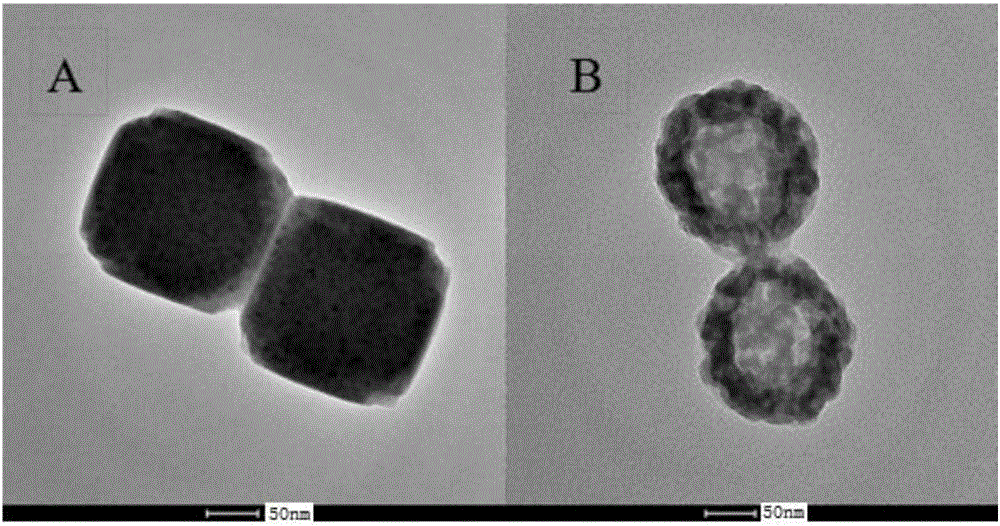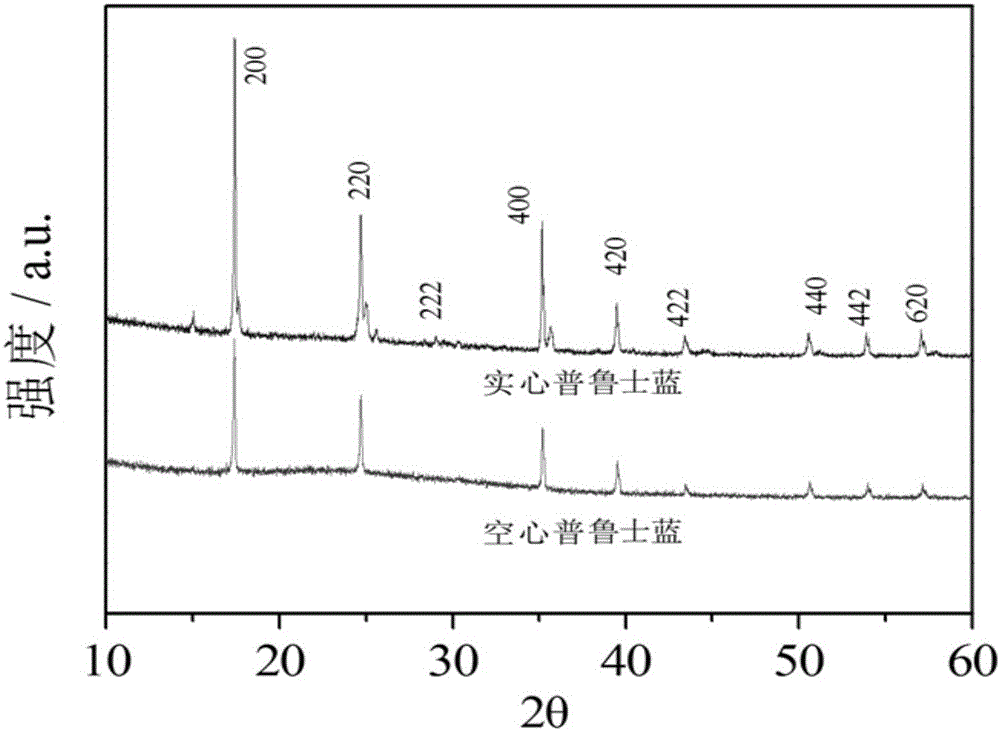Preparation method and application of hollow Prussian-blue nanometer cube
A nano-cube, Prussian blue technology, applied in the field of electrochemistry, can solve the problems of easy agglomeration, difficult to form hollow three-dimensional nanostructures, and reduced catalytic performance, and achieve the effect of improving specific surface area, low cost, and good catalytic performance.
- Summary
- Abstract
- Description
- Claims
- Application Information
AI Technical Summary
Problems solved by technology
Method used
Image
Examples
Embodiment 1
[0038] First, 3.0 g of polyvinylpyrrolidone was weighed and dispersed in 40 mL of dilute hydrochloric acid (0.01 M) aqueous solution by ultrasonic. Then 0.11 g of potassium ferricyanide was weighed and added to the above solution with stirring. After 30 min, the solution was placed on an electric furnace and heated at 80° C. for 20 h. After being aged, the solution was centrifuged, washed and dried to obtain solid Prussian blue nanocubes with a particle size of 100-150 nm for the next preparation.
[0039] First, 20 mg of solid Prussian blue nanocubes and 200 mg of polyvinylpyrrolidone were ultrasonically dispersed in 20 mL of 1.0 M hydrochloric acid solution, then the solution was transferred to a hydrothermal reactor and sealed, reacted at 140 ° C for 4 h, and after natural cooling, the The solution in the reaction kettle is centrifugally washed and dried to obtain a hollow Prussian blue nanocube material with a particle size of 80-130 nm.
[0040] The schematic diagram of ...
Embodiment 2
[0043] First, 2.0 g of polyvinylpyrrolidone was weighed and dispersed in 40 mL of dilute hydrochloric acid (0.01 M) aqueous solution by ultrasonic. Then 0.165 g of potassium ferricyanide was weighed and added to the above solution with stirring. After 30 min, the solution was placed on an electric furnace and heated at 80° C. for 20 h, placed for ageing, centrifuged, washed and dried to obtain solid Prussian blue nanocubes for the next preparation.
[0044] First, 20 mg of solid Prussian blue nanocubes and 100 mg of polyvinylpyrrolidone were ultrasonically dispersed in 20 mL of 1.0 M hydrochloric acid solution, then the solution was transferred to a hydrothermal reactor and sealed, reacted at 150 ° C for 4 h, and after natural cooling, the The solution in the reaction kettle is centrifuged, washed and dried to obtain hollow Prussian blue nanocubes.
[0045] Different composition materials are prepared by adjusting polyvinylpyrrolidone, temperature and reaction time according ...
Embodiment 3
[0047] In the specific measurement, the glassy carbon electrode modified by the hollow Prussian blue nanocube material prepared in Example 1 was used as the working electrode, the saturated calomel electrode was used as the reference electrode, and the platinum electrode was used as the auxiliary electrode. The electrolyte was a 0.02M PBS (pH 6.5) solution containing 0.1M potassium chloride.
[0048] According to the preparation method of Example 1, solid Prussian blue nanocubes and hollow Prussian blue nanocubes were prepared respectively, and 5 μg of solid Prussian blue nanocubes and hollow Prussian blue nanocubes were coated on glassy carbon electrodes, respectively, and the modified electrodes were detected. Electrocatalytic performance of hydrogen peroxide.
[0049] like Figure 5 As shown in the cyclic voltammogram of Figure 5 Compared with the solid Prussian blue nanocube material, the response current of the hollow Prussian blue nanocube material is 1 times larger, ...
PUM
| Property | Measurement | Unit |
|---|---|---|
| particle diameter | aaaaa | aaaaa |
| particle diameter | aaaaa | aaaaa |
Abstract
Description
Claims
Application Information
 Login to View More
Login to View More - R&D
- Intellectual Property
- Life Sciences
- Materials
- Tech Scout
- Unparalleled Data Quality
- Higher Quality Content
- 60% Fewer Hallucinations
Browse by: Latest US Patents, China's latest patents, Technical Efficacy Thesaurus, Application Domain, Technology Topic, Popular Technical Reports.
© 2025 PatSnap. All rights reserved.Legal|Privacy policy|Modern Slavery Act Transparency Statement|Sitemap|About US| Contact US: help@patsnap.com



